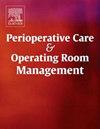Prevalence of mobile device use among healthcare providers in the operating theatres: Perceptions and distractions
IF 1
Q2 Nursing
Perioperative Care and Operating Room Management
Pub Date : 2025-01-30
DOI:10.1016/j.pcorm.2025.100474
引用次数: 0
Abstract
Background
Distractions in the operating theatre can significantly impair surgical performance and patient safety. This study investigates the various sources of distractions, particularly focusing on technological and non-technological factors, and their differential impact across various occupational roles within anesthesiology.
Methods
A cross-sectional study was conducted involving 169 anes- thesiology professionals categorized into three groups: residents, technicians, and specialists. Data were collected via structured questionnaires, capturing both quantitative and qualitative aspects of workplace distractions. Statis- tical analysis included ANOVA, Kruskal-Wallis tests, Pearson's chi-square test, and multivariate analysis of covariance, adhering to STROBE guide- lines.
Results
The multivariate analysis of covariance revealed significant occupational effects on distraction-related variables (Pillai's Trace = 0.323, F(32, 298) = 1.80, p = 0.007). Significant findings included higher levels of mobile phone use for texting, gaming, and media consumption among specialists compared to other groups. Texting on the phone (F(2, 163) = 6.37, p = 0.002), playing games on phone (F(2, 163) = 8.39, p < 0.001), and watching movies/series on phone (F(2, 163) = 4.15, p = 0.018) were notably higher among specialists.
Conclusion
The study highlights the need for comprehensive inter- ventions to mitigate the effects of distractions in surgical environments, in- cluding policy formulation for mobile device usage and strategies to improve team dynamics and environmental conditions. Future research should focus on longitudinal assessments to evaluate the effectiveness of interventions and explore the broader implications across different healthcare settings.
手术室中医疗服务提供者使用移动设备的普遍程度:感知和干扰
手术室中的干扰因素会严重影响手术效果和患者安全。本研究调查了各种分散注意力的来源,特别关注技术和非技术因素,以及它们在麻醉学中不同职业角色的不同影响。方法采用横断面研究方法,将169名医学专业人员分为住院医师、技术人员和专科医生三组。数据通过结构化问卷收集,从定量和定性两个方面捕捉工作场所干扰因素。统计分析包括方差分析、Kruskal-Wallis检验、Pearson卡方检验和多变量协方差分析,遵循STROBE指南。结果多变量协方差分析显示,职业对分心相关变量有显著影响(Pillai’s Trace = 0.323, F(32,298) = 1.80, p = 0.007)。重要的发现包括,与其他群体相比,专家使用手机发短信、玩游戏和媒体消费的比例更高。在手机上发短信(F(2,163) = 6.37, p = 0.002),在手机上玩游戏(F(2,163) = 8.39, p <;通过手机观看电影/电视剧(F(2,163) = 4.15, p = 0.018)的比例在专业人群中明显更高。结论本研究强调需要采取综合干预措施来减轻手术环境中分心的影响,包括制定移动设备使用的政策和改善团队动态和环境条件的策略。未来的研究应侧重于纵向评估,以评估干预措施的有效性,并探索在不同医疗保健环境中更广泛的影响。
本文章由计算机程序翻译,如有差异,请以英文原文为准。
求助全文
约1分钟内获得全文
求助全文
来源期刊

Perioperative Care and Operating Room Management
Nursing-Medical and Surgical Nursing
CiteScore
1.30
自引率
0.00%
发文量
52
审稿时长
56 days
期刊介绍:
The objective of this new online journal is to serve as a multidisciplinary, peer-reviewed source of information related to the administrative, economic, operational, safety, and quality aspects of the ambulatory and in-patient operating room and interventional procedural processes. The journal will provide high-quality information and research findings on operational and system-based approaches to ensure safe, coordinated, and high-value periprocedural care. With the current focus on value in health care it is essential that there is a venue for researchers to publish articles on quality improvement process initiatives, process flow modeling, information management, efficient design, cost improvement, use of novel technologies, and management.
 求助内容:
求助内容: 应助结果提醒方式:
应助结果提醒方式:


